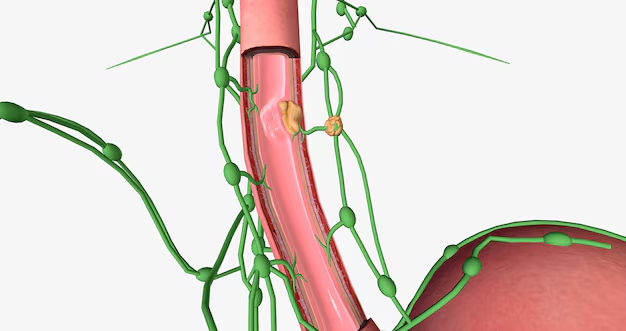How is esophageal cancer diagnosed?
Esophageal cancer is more frequent after the age of 60. Endoscopic biopsy and endoesophageal ultrasound are important diagnostic tools. The biopsy specimen is microscopically analyzed and a pathological diagnosis is made.
What are the types of esophageal cancer?
There are two main types of esophageal cancer. One of them arises from the cells that form the inner lining of the esophagus and is named as squamous cell carcinoma. Other one arises from the glands or transformed cells due to chronic reflux in the esophagus and is named adenocarcinoma. Squamous cell carcinoma is directly related with smoking, alcohol intake and very hot liquid ingestion, whereas adenocarcinoma is more correlated with alcohol intake, obesity and chronic reflux. Esophagus travels from neck to the abdomen and cancer can arise from any location in the esophagus. It can be in the upper or lower parts.


What are the stages of esophageal cancer?
Esophageal cancer is evaluated in four stages like other cancers. The stage is determined according to the invasion of the wall of the esophagus and degree of lymph node involvement. Cancers located just in the lining of the esophagus and without lymph node involvement are in the earliest stages. Stage 4 is the most advanced and designates distant metastasis.
Can esophageal cancer be treated with surgical resection?
Surgical resection is the main treatment option in the first three stages of esophageal cancer. If the tumor does not extend beyond the esophageal wall and less than 3 lymph nodes are involved main treatment option is surgical resection. This is especially valid for cancers located in middle or distal esophagus.
During surgical resection at least 16 lymph nodes should be removed along with the cancer. In stage 3 esophageal cancer, chemotherapy and radiation should be given before surgery to make the tumor smaller and control lymph node spread. In very early esophageal cancers limited to the inner lining (mucosa), endoscopic mucosal resection is also an important option.
Are there any other treatment methods other than surgery?
In patients older than 75 years and with comorbidities, chemoradiation may be preferred to surgery due to the risks of surgical resection. Additionally stage 4 esophageal cancer is typically treated/palliated with chemoradiation. In squamous cell carcinoma patients chemoradiation may be the first option if surgical resection is risky. In cancers located in upper esophagus (cervical/neck area), due to the frequent need of laryngeal resection and no difference in overall success, chemoradiation is the first treatment option.
How is esophageal cancer operation performed?
Esophageal cancer resection (esophagectomy) is a sophisticated surgical procedure. If the cancer is located at the entrance of the stomach or distal 1/3rd of the esophagus, surgery starts from the abdomen and ends in th chest. If cancer is located in middle or upper esophagus, surgery starts in the chest, continues in the abdomen and ends with a left neck intervention. Esophagectomy is not only removal of cancer and lymph nodes. It involves reconstruction of gastrointestinal continuity after resection. Thus once cancer and lymph nodes are removed, a tube is formed from stomach or rarely from colon (large bowel) or jejunum (small bowel) to replace the esophagus.
What is minimally invasive Esophageal Resection (Esophagectomy)?
Minimally invasive surgery is performed using video camera view through 3-4 small (1-2 cm wide) incisions in the abdomen and 1-2 small incisions (2/4 cm wide) in the chest instead of two big incisions. In our current level of experience we usually make 3 small incisions in the abdomen and one small incision in the chest. Such small incisions decrease the surgical trauma, facilitate faster healing and minimizes postoperative pain. We can perform those surgeries within 2,5-3 hours (1 hour in the abdomen and 1,5-2 hours in the chest). You can watch a uniportal esophagectomy video from the link below.


What are the risks of esophageal cancer resection (Esophagectomy)?
Following esophageal cancer resection, healing problems can be observed in the junction between esophagus and stomach tube or in the stomach tube itself. This risk is less than 10%. A leak can occur at the anastomotic (junction) area between esophagus and stomach and this may lead to pneumonia, even sepsis causing prolonged hospital stay. This is a risky complication that may need additional interventions. In cancers located at the upper area, injury to the nerves of vocal cords can be seen leading to hoarseness. Additionally, cardiac rythym anomalies, secretions in the lungs and lymphatic leak are also possible problems that can arise after surgery.
Are stents used in esophageal cancer management?
Stents can be used to open the lumen of the esophagus and enable patients to eat. Patients can eat solid food after placement of stents. It is especially recommended in advanced stage patients and those who are not planned for surgery. It causes a foreign body reaction in the esophagus and makes a surgical resection difficult.






